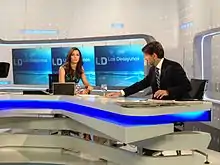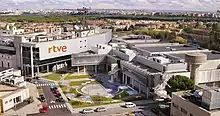RTVE
The Corporación de Radio y Televisión Española, S.A.[2] ("Spanish Radio and Television Corporation"; RTVE) is the state-owned public corporation that assumed the indirect management of the Spanish public radio and television service formerly called Ente Público Radiotelevisión Española in 2007. RTVE is the largest audiovisual group in Spain broadcasting in the Spanish language. Since January 2010 it is financed exclusively by public subsidies.
 | |
| Type | State-owned corporation |
|---|---|
| Industry | Mass media |
| Genre | Public broadcasting service |
| Headquarters | , Spain |
Area served | Spain |
Key people | Rosa María Mateo, Sole Administrator |
| Services | Television, radio, online |
| Revenue | |
| Owner | SEPI (100%) |
Number of employees | 6,500 |
| Subsidiaries | Radio Nacional de España Televisión Española |
| Website | rtve.es |
Role as a public broadcaster
In the exercise of its public service function, among the obligations of the RTVE Corporation are:
- Promote dissemination and awareness of constitutional principles and civic values.
- Guarantee the objectivity and truthfulness of the information provided, while ensuring that a broad range of views is presented.
- Facilitate democratic debate and the free expression of opinion.
- Promote the territorial cohesion and linguistic and cultural diversity of Spain.
- Offer access to different genres of programming and to the institutional, social, cultural, and sporting events that are of interest to all sectors of the audience, paying attention to those topics that are of special interest to the public.
- To serve the widest audience, ensuring maximum continuity and geographical and social coverage, with a commitment to quality, diversity, innovation, and high ethical standards.
History

RTVE throughout its history has undergone numerous restructurings and reorganisations, and has assumed numerous identities. The history of RTVE begins in 1937 with the first broadcasts by Radio Nacional de España (RNE—Spanish National Radio) from the city of Salamanca. In these early years, RNE served as a propaganda tool for the Nationalist forces during the Spanish Civil War; it would later be used by Francisco Franco to inform the Spanish public.
The national radio service depended successively on the FET y de las JONS's Vice-Secretariat of Popular Education, on the Ministry of National Education (since 1945) and on the Ministry of Information and Tourism, since the creation of the latter in 1951.[3] It was in July 1945, as competencies over Press and Propaganda were transferred to the Ministry of National Education when radio broadcasting became a standalone directorate general: the Dirección General de Radiodifusión ("Directorate General for Radio Broadcasting").[4]
Television was officially introduced in Spain in October 1956, and in October 1973 the two broadcasting networks, RNE and Televisión Española (TVE—Spanish Television) were consolidated into the Servicio Público Centralizado RadioTelevisión Española (RTVE Centralised Public Service).
Further consolidations followed in 1977, at which time RTVE became an organismo autónomo. In 1979, TVE and RNE were joined by Radiocadena Española (RCE), an old radio service that, unlike RNE, could broadcast commercials. In 1980, RTVE was configured, by statute, as a legal public entity with its own jurisdiction.[5] According to RTVE's annual report (2003): "This law arose from the Spanish Constitution and the political pluralism which the constitution asserts as a fundamental value of the rule of law; and in this spirit granted RTVE the right to function as a democratic organisation."[6] The former cinema newsreels service NO-DO was merged into RTVE to be dismantled in 1981. Since then, the NO-DO archives are property of RTVE and its conservation is on their hands and Filmoteca Nacional's. In 1989, RCE was dismantled and its radio service was merged into RNE.

In accordance with the Law of State Radio and Television of 5 June 2006,[7] and in the face of an enormous deficit, the RTVE Public Body and the companies TVE, S.A. and RNE, S.A were dissolved, and on 1 January 2007, Corporación RTVE came into existence.[8] This change in the law put Corporación RTVE in control of Spain's public radio and television service.
As part of the 2007 restructuring, a controversial plan was put into action to reduce the workforce by 4,855 through attrition and retirement incentives, in spite of the fact that RTVE was the major European public broadcasting service with the smallest workforce.
In 2012 political tensions associated with the austerity program of the conservative ruling party, Partido Popular (PP) resulted in personnel changes which displaced journalists interviewed by the centre-left The Guardian, interpreted as an effort to remove critical political comment from RTVE's content. In 2012 the PP began staffing RTVE with party veterans.[9] Considerable controversy was caused when Ana Pastor was fired.[9]
On 11 June 2013, RTVE was one of the few known European broadcasters to condemn and criticise the closure of Greece's state broadcaster ERT.
In December 2018, RTVE launched a web with Filmoteca Española, which is available via Internet with more than 4000 videos of Spanish films and documentaries.[10]
Television channels
RTVE's own television service comes under the Televisión Española (TVE) division of RTVE. All of TVE's channels broadcast in Spanish, with the exception of the broadcast of Catalan-language segments in La 1 and La 2 in the territory of Catalonia produced by TVE Catalunya.
| Channel's logo | Type of programming |
|---|---|
|
La 1: Colloquially known as La Uno (The One) and formerly as TVE1, La Primera (The First). La 1 is a generalist channel which mainly broadcasts news reports, news programmes, documentaries, magazine programmes, TV series, films (particularly Spanish and American films) and some popular sports competitions. It was Spain's first TV channel and is currently its third most watched. | |
|
La 2: Colloquially known as La Dos (The Two) and formerly as TVE2, Segunda Cadena (Second Channel), or UHF. La 2 mainly broadcasts cultural programming, North American TV series, documentaries, Spanish and European films, news reports, debates and musicals. It offers a different aspect from its generalist sister channel, La 1. | |
|
24h: 24 Horas is RTVE's 24-hour news channel created in 1997. It broadcasts news reports, debates, analyses, interviews as well as rolling news. It was Spain's first 24-hour news channel. | |
|
Clan: Formerly known as Clan TVE. Clan is a children's channel but also offers some programming aimed at teenagers during the evening and repeats TVE content from other channels during the early hours. | |
|
Teledeporte: Teledeporte broadcasts sporting competitions that can not be broadcast on La 1 and La 2 due to lack of interest from the audience. | |
|
La 1 HD: La 1 in High-definition. | |
|
La 2 HD: La 2 in High-definition. | |
|
Clan HD: Clan in High-definition. | |
|
Teledeporte HD: Teledeporte in High-definition. | |
|
TVE Internacional: RTVE international television channel. It was created in 1989 and broadcasts TVE content throughout the world. | |
|
Star HD: International entertainment television channel, broadcast by satellite to Latin America and Europe. Launched in 2016. |
Radio stations
RTVE's radio stations come under the Radio Nacional de España (RNE) division of RTVE.
| Station logo | Type of programming |
|---|---|
|
Radio Nacional: (formerly known as Radio 1) Radio Nacional is RTVE's generalist radio station. Its programming is mainly news and other programmes. It started broadcasting in 1937. | |
|
Radio Clásica: (formerly known as Radio 2) Radio Clásica mainly broadcasts classical music. It started broadcasting in 1965. | |
|
Radio 3: Radio 3 broadcasts cultural and alternative programming aimed at young people. It started broadcasting in 1979. | |
|
Ràdio 4: Ràdio 4 is RTVE's Catalan-language station aimed at people living in Catalonia and other Catalan-speaking territories. It was created in 1988 after the closure of Radiocadena Española. | |
|
Radio 5: (formerly known as Radio 5 Todo Noticias) is RTVE's 24-hour radio news station. It started broadcasting in 1994. | |
|
Radio Exterior: International broadcasting service on short wave, with an audience of 80 million listeners (surpassed only by the BBC and Vatican Radio). This station is also transmitted via DAB for Spain and by satellite. Transmissions are in Spanish, French, Arabic, Ladino, Portuguese, Russian and English. |
RTVE is also responsible for the Instituto Oficial de Radio y Televisión (IORTV, Official Institute of Radio and TV) and the Orquesta Sinfónica y Coro de RTVE (RTVE Symphony Orchestra and Choir). RTVE (as RNE) was admitted to full active membership of the European Broadcasting Union in 1955. TVE joined the Eurovision Network in 1960. The corporation has contributed to the production of more than 300 films, many of which have received awards at international film festivals around the world. From 1979 to 1987, a second radio network known as Radiocadena Española was also a part of RTVE.[11] RCE stations, unlike RNE, showed advertising. RCE was merged into RNE between 1987 and 1989.[12] NO-DO was also merged into RTVE in 1980. Since NO-DO's closure in 1982, RTVE and Filmoteca Española are responsible for maintaining NO-DO's archives.[13]
Internet

RTVE offers an online portal at rtve.es. The website is managed by RTVE's Interactive Media department (Interactivos RTVE) and allows users to listen and watch live feeds of the network's radio and television stations. The portal also features blogs, news stories and offers an online catch-up service called "A la carta".
Management

Pursuant to the 2006 Law of State Radio and television,[7] management of the national public service is entrusted to Corporación RTVE.[14] The Board (Consejo de Administración) of the RTVE is the main body of RTVE, and appoints the executive officers of RTVE and its companies, approves its organisation, and approves most major activities.[15][16] The Board is composed of 12 members; 8 members are chosen by Congress and 4 by the Senate, each by two-thirds majority and each for a non-renewable mandate of 6 years, and 2 members appointed by Congress must be proposed by the 2 main trade unions at RTVE.[15]
The Chair has operational control of day-to-day operations, in order to execute the decisions and guidance of the Board.[16][14] The Chair is appointed by, and may be dismissed by, Congress.[14] Before the 2006 Act, this position was filled by the role of the Director General, which had a de facto total control of RTVE.[17] In practice, the Director General had been chosen by the Government for their political profile.[18]
Corporación RTVE is described as a "state mercantile society" (sociedad mercantil estatal) with special autonomy and independence from the government and the general state administration, and it performs its functions through TVE and RNE.
Most staff are civil servants.[14] The News Council is an internal supervisory body composed of RTVE journalists with the aim of safeguarding RTVE's independence.[14]
Director Generals of Radiodifusión y Televisión
- José María Revuelta Prieto (1957–1962)
- Roque Pro Alonso (1962–1964)
- Jesús Aparicio-Bernal Sánchez (1964–1969)
- Adolfo Suárez González (1969–1973)
- Rafael Orbe Cano (1973–1974)
- Juan José Rosón Pérez (1974)
- Jesús Sancho Rof (1974–1975)
- Gabriel Peña Aranda (1975–1976)
- Rafael Anson Oliart (1976–1977)
Director General of Organismo Autónomo RTVE
- Fernando Arias-Salgado Montalvo (1977–1981)
Director Generals of Ente Público RTVE
- Fernando Castedo Álvarez (1981)
- Carlos Robles Piquer (1981–1982)
- Eugenio Nasarre Goicoechea (1982)
- José María Calviño Iglesias (1982–1986)
- Pilar Miró Romero (1986–1989)
- Luis Solana Madariaga (1989–1990)
- Jordi García Candau (1990–1996)
- Mónica Ridruejo Ostrowska (1996–1997)
- Fernando López-Amor García (1997–1998)
- Pío Cabanillas Alonso (1998–2000)
- Javier González Ferrari (2000–2002)
- José Antonio Sánchez Domínguez (2002–2004)
- Carmen Caffarel Serra (2004–2007)
President of Corporación RTVE
- Luis Fernández Fernández (2007–2009)
- Alberto Oliart Saussol (2009–2011)
- Leopoldo González-Echenique Castellanos de Ubao (2011–2014)
- José Antonio Sánchez Domínguez (2014–2018)[19]
- Rosa María Mateo Isasi (2018–)
Correspondents
Televisión Española
|
Radio Nacional de España
|
References
- "Reunión del Consejo de Administración de RTVE de 28 de febrero de 2018. RTVE cierra sus cuentas de 2017 con un resultado positivo de 25 millones de euros". RTVE.es (in Spanish). 28 February 2018. Retrieved 29 April 2018.
- "Corporación RTVE". Rtve.es (in Spanish). Archived from the original on 8 September 2013. Retrieved 16 August 2013.
- Gómez García, Salvador; Martín Quevedo, Juan (2012). "Del Yugo a la Cruz. Radio Nacional de España: una radio en transición (1945-1951)". Área Abierta. Madrid: Ediciones Complutense. 12 (3): 3. doi:10.5209/rev_ARAB.2012.v33.40556.
- Cal, Rosa (1999). "Apuntes sobre la actividad de la Dirección General de Propaganda del Franquismo (1945-1951)". Historia y Comunicación Social. Madrid: Ediciones Complutense (4): 22. ISSN 1137-0734.
- "Ley 4/1980, de 10 de enero, de Estatuto de la Radio y la Televisión". Boletín Oficial del Estado (in Spanish). Radio and Television Statute. 10 January 1980. Retrieved 13 June 2019 – via Noticias Jurídicas.
- Informe Anual sobre el Cumplimiento de la Función de Servicio Público del Grupo Radiotelevisión Española en 2003 (PDF). Ente Público RadioTelevisión Española (in Spanish). Madrid: Dirección Gerencia Internacional y Corporativa de RTVE Subdirección de Estudios Corporativos de RTVE. 2004. p. 14. Archived from the original (PDF) on 28 May 2008. Retrieved 15 April 2007.
- R., Juan Carlos (6 June 2006). Rodríguez Zapatero, José Luis (ed.). "Ley 17/2006, de 5 de junio, de la radio y la televisión de titularidad estatal" (PDF). Boletín Oficial del Estado (in Spanish) (134): 20. Archived from the original (PDF) on 12 December 2015. Retrieved 13 June 2019 – via RTVE.
- "El mayor grupo audiovisual español". RTVE (in Spanish). 1 January 2007. Archived from the original on 24 July 2014. Retrieved 13 June 2019.
- Burgen, Stephen (5 August 2012). "Spanish government accused of purging critics from national radio and TV: Journalists who have questioned the party's austerity policy have lost jobs at RTVE". The Guardian. Barcelona: Guardian News & Media Limited. Retrieved 6 August 2012.
- "RTVE y Filmoteca Española lanzan en internet el mayor fondo histórico audiovisual de España". Corporación de Radio y Televisión Española (in Spanish). 20 December 2018. Retrieved 3 January 2019.
- "Radiocadena Española y No-Do se integran en RTVE". Elpais.com (in Spanish). Prisa. 5 December 1978. Retrieved 16 August 2013.
- Contreras, José Miguel (21 July 1988). "Aprobada la fusión de Radio Nacional de España y Radiocadena Española". Elpais.com (in Spanish). Madrid: Prisa. Retrieved 16 August 2013.
- "Ley 4/1980, de 10 de enero, de Estatuto de la Radio y la Televisión". Boletín Oficial del Estado (in Spanish). 12 January 1980. Retrieved 16 August 2013 – via Noticias Jurídicas.
- Perez 2009, p. 67.
- Perez 2009, p. 66.
- "Statement on RTVE website about the creation of Corporación TVE". Corporación RTVE (in Spanish). Archived from the original on 9 September 2012. Retrieved 13 June 2019.
- Perez 2009, pp. 67–68.
- Perez 2009, p. 68.
- Agencias (22 October 2014). "El Congreso designa a José Antonio Sánchez nuevo presidente de RTVE". El País (in Spanish). PRISA. Retrieved 22 January 2015.
- "Corresponsalías RTVE" (in Spanish). rtve.es.
Bibliography
- Pérez Gómez, Alberto (2007). Nikoltchev, Susanne (ed.). Iris Special: The Public Service Broadcasting Culture. Strasbourg: European Audiovisual Observatory. ISBN 978-92-871-6188-8.
External links
- Official website (in Spanish)